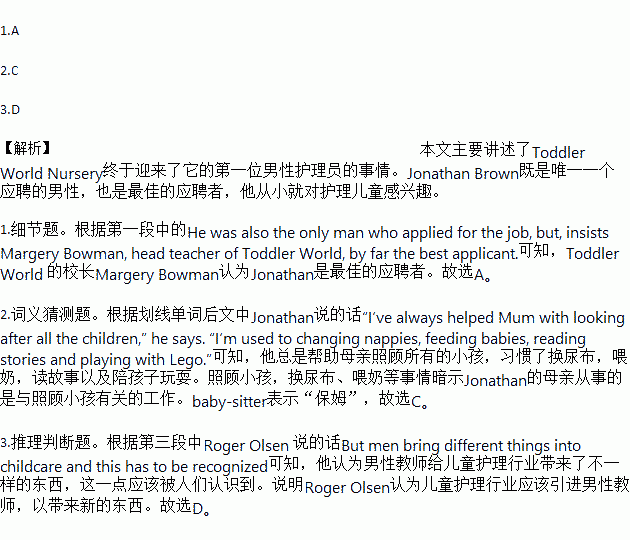题目内容
Toddler World Nursery was delighted to employ a trainee---twenty-two-old Jonathan Brown—as their first male nursery schoolteacher. He was also the only man who applied for the job, but, insists Margery Bowman, head teacher of Toddler World, by far the best applicant. “Both boys and girls will benefit from the experience of having a male role model in the nursery.” Says mother of two, Margery.
Jonathan has always been interested in childcare. His own mother is a childminder and his father is a teacher. “I’ve always helped Mum with looking after all the children.” he says. “I’m used to changing nappies, feeding babies, reading stories and playing with Lego.”
But Jonathan is a rare male in a female world. Only 2% of nursery teachers are men and this hasn’t changed for ten years. Roger Olsen of the National Nursery Trust said, “Men are often viewed with anxiety and suspicion(怀疑)in a children’s environment. Or they are expected to do things the way women would do them. But men bring different things into childcare and this has to be recoginsed.” Jonathan agrees. He is a qualified under-7s football coach, and plants to introduce football lessons to the nursery for boys and girls.
What do Jonathan’s friends think of his choice of career?
“Actually, most of them are pretty cool about it now.” he says, “though they do make jokes about nappies. And I’ve found that girls are actually quite impressed – so that’s good!”
1.Why was Jonathan employed by Toddler World Nursery?
A. He was the best among all the applicants.
B. He was the only man who applied for the job.
C. He would be able to teach kids to play football.
D. He would do things the way women would do them.
2.Which of the following can replace the underlined word “childminder” (Para.2)?
A. Instructor.
B. Superior.
C. Baby-sitter.
D. Coach.
3.What did Roger Olsen say about the job of childcare?
A. It has been women-specific.
B. It requires people’s understanding.
C. It takes time to make some changes.
D. It needs men teachers to bring something different.
 天天向上一本好卷系列答案
天天向上一本好卷系列答案 小学生10分钟应用题系列答案
小学生10分钟应用题系列答案
